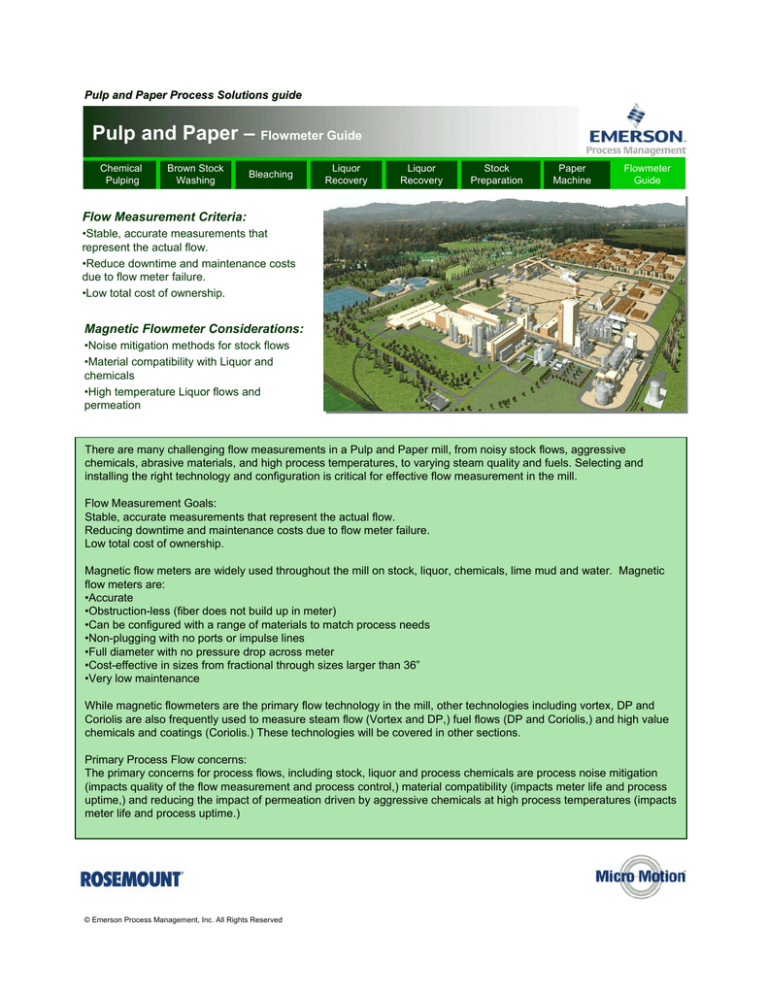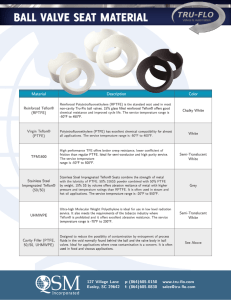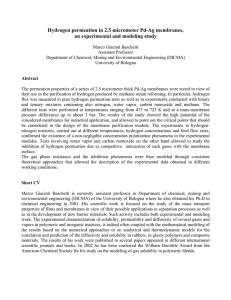
Pulp and Paper Process Solutions guide
Pulp and Paper – Flowmeter Guide
Chemical
Pulping
Brown Stock
Washing
Bleaching
Liquor
Recovery
Liquor
Recovery
Stock
Preparation
Paper
Machine
Flowmeter
Guide
Flow Measurement Criteria:
•Stable, accurate measurements that
represent the actual flow.
•Reduce downtime and maintenance costs
due to flow meter failure.
•Low total cost of ownership.
Magnetic Flowmeter Considerations:
•Noise mitigation methods for stock flows
•Material compatibility with Liquor and
chemicals
•High temperature Liquor flows and
permeation
There are many challenging flow measurements in a Pulp and Paper mill, from noisy stock flows, aggressive
chemicals, abrasive materials, and high process temperatures, to varying steam quality and fuels. Selecting and
installing the right technology and configuration is critical for effective flow measurement in the mill.
Flow Measurement Goals:
Stable, accurate measurements that represent the actual flow.
Reducing downtime and maintenance costs due to flow meter failure.
Low total cost of ownership.
Magnetic flow meters are widely used throughout the mill on stock, liquor, chemicals, lime mud and water. Magnetic
flow meters are:
•Accurate
•Obstruction-less (fiber does not build up in meter)
•Can be configured with a range of materials to match process needs
•Non-plugging with no ports or impulse lines
•Full diameter with no pressure drop across meter
•Cost-effective in sizes from fractional through sizes larger than 36”
•Very low maintenance
While magnetic flowmeters are the primary flow technology in the mill, other technologies including vortex, DP and
Coriolis are also frequently used to measure steam flow (Vortex and DP,) fuel flows (DP and Coriolis,) and high value
chemicals and coatings (Coriolis.) These technologies will be covered in other sections.
Primary Process Flow concerns:
The primary concerns for process flows, including stock, liquor and process chemicals are process noise mitigation
(impacts quality of the flow measurement and process control,) material compatibility (impacts meter life and process
uptime,) and reducing the impact of permeation driven by aggressive chemicals at high process temperatures (impacts
meter life and process uptime.)
© Emerson Process Management, Inc. All Rights Reserved
Pulp and Paper Process Solutions guide
Noise Mitigation Technology For Improved Stock Flow Control
Noise mitigation for improved control:
The fiber impinging on the electrodes results in high levels of noise on the electrodes, making it difficult to make
consistent and accurate flow measurements. AC magnetic flow meters overcame process noise with brute force,
applying full line current to the magnetic coils and generating a large signal that could be read above the noise. AC
meters, however, have limited accuracy (made worse by unpredictable zero drift,) are inefficient, and are not very
robust. DC flow meter technology improved accuracy, efficiency and reliability, however in some cases the signal
noise caused the customer to add excessive damping to get a signal that could be used by the control system.
Unfortunately, the damped signal often was not responsive enough to real changes in the flow and could not ultimately
be used to automatically control the process. Rosemount has developed several noise mitigation techniques for their
DC meters to overcome process noise while maintaining response including:
•Sensitive front end electrode signal conditioning
•Selectable Coil Drive Frequency
•Digital Signal Processing
•High Signal DC
Table: Process Noise Considerations
Stock
Consistency
Chemical
addition
5 Hz
37.5 Hz
37.5 HZ w/DSP
0 – 6%
4 – 10%
6 – 10+%
Add 1% point for chemical addition
Fiber Length
Short fiber
(recycle): subtract
1%
Medium fiber
(writing paper): no
change
Long fiber
(container board):
add 1%
Velocity
(normal flow)
Less than 3 ft/s:
subtract 1%
Between 3 and 10
ft/s: no change
Exceeds 10 ft/s:
add 1%
Viscosity
Solids content
Low Viscosity: no change
High Viscosity: add 1%
No change when low solids
content
Add 1% when large solids
(knots, staples, etc.) are
present
This chart provides some basic considerations for when to use the default 5hz coil drive frequency, when to change
the frequency to 37.5 hz and when DSP may provide additional noise mitigation. (Selectable coil frequency and DSP
are standard features on the E-Series 8732 and 8712 transmitters.) If, for example, the customer is measuring a 5%
stock at a velocity over 10 ft/sec with knots and staples, the effective stock consistency would be 5%+1%+1%, or 8%.
If the signal appears noisy, the customer may want to move the coil drive frequency from the default 5 Hz to the higher
coil drive frequency of 37.5 Hz. This change is easily done through the LOI, a 475 hand held or AMS. (Note: The
transmitter must be Auto Zeroed whenever the coil drive frequency is changed. This is done after the frequency has
been changed and with the tube full, and is also initiated through the LOI, 475 or AMS. Auto Zeroing initializes the
transmitter and establishes a new zero reference at the new frequency.)
Typically, magnetic flowmeters operate at a fixed coil drive frequency. The flowmeter coils are pulsed at a low
frequency, creating the magnetic fields used to measure flow and are optimized at a frequency that provides stable
flow measurement of most chemical fluids. (Rosemount magnetic flowmeters are factory set for standard operation at
5 hz.)
© Emerson Process Management, Inc. All Rights Reserved
Pulp and Paper Process Solutions guide
Impingement noise common to stock flows is typically highest at low frequencies, and decays naturally as the
frequency increases, resulting in high levels of noise at the normal operating frequency of most magnetic flowmeters.
The higher level of noise compared to the flow signal results in lower signal to noise ratios and inaccurate, irregular
flow measurement.
¾
Most magnetic flowmeters operate at low coil
drive frequencies, where impingement noise
can result in low signalsignal-toto-noise ratios
¾
Rosemount’
Rosemount’s selectable frequency capability
allows the mill to increase the coil frequency to
a frequency with less impingement noise,
resulting in a higher signalsignal-toto-noise ratio
Advanced Diagnostics Detect High Process Noise
The optional E-Series advanced flowmeter diagnostics include a process noise diagnostic, which monitors the signal
to noise ratio and indicates when the ratio has fallen below acceptable levels for good control. The operator can
access the signal to noise ratios at both available frequencies through the Local Operator Interface (LOI) or through
AMS, and can easily change coil drive to the frequency that provides the strongest signal. (Note: For best
performance, flowmeter must be auto zeroed when the coil frequency is changed.)
High process noise diagnostics via the LOI or AMS
© Emerson Process Management, Inc. All Rights Reserved
Pulp and Paper Process Solutions guide
Material Selection for Extended Life and Improved Process Uptime
Selecting the right Materials
Selecting the best liner and electrode materials for the process is critical to extending the life of the flowmeter and
reducing issues associated with meter failure. The harsh chemicals including caustic and high concentration bleach
chemicals, high process temperatures and abrasion due to pulp stock solids provide unique challenges. Teflon is the
most commonly used liner material in the mill due its good resistance to chemicals and abrasion. (Less expensive liner
alternatives can provide good service in utility and water applications.) Electrode materials can be matched to provide
corrosion resistance for the specific chemicals. Beyond basic material selection, the mill can take additional steps to
significantly extend meter life in the most challenging applications.
•
Combination of high temperature and harsh
chemicals can increase permeation of Teflon liners
•
Permeation shows up as “blisters” or “bubbles” and
can cause premature failure and reduced up-time
–
Permeation rates are driven by temperature gradients
Teflon Blistering in a High Temperature
Black Liquor Application
High Temperature Liquors and Permeation
Black and White liquor are the most aggressive applications in the mill as the combination of high temperature and
harsh chemicals can drive permeation in Teflon liners. Permeation is the molecular diffusion of a fluid or vapor through
the liner over time, and shows up as “blisters”, or “bubbles” and can cause premature failure and reduced up-time.
Permeation rates can be effected by temperature gradients where the heat moves from the hot process fluid towards
the ambient surroundings, driving fluid permeation. The movement within mills to increase production and efficiency by
increasing temperature increases the incidence of permeation. Resistance to permeation can be increased through
selection of the correct Teflon resin, manufacturing the liner in a manner that increases resistance, and increasing the
amount of liner that must be permeated. (Resistance to permeation is increased proportionally to the square of the
thickness.) Another method for reducing the rate of permeation is to reduce the temperature variation between the
process and ambient, and will be covered later in this guide.
© Emerson Process Management, Inc. All Rights Reserved
Pulp and Paper Process Solutions guide
Liner Materials and Manufacture
There are many different Teflon resins and processes for manufacturing liners. PTFE is the most common form of
Teflon, and generally the best value for most mill flows. When choosing a PTFE liner, select a PTFE liner that is
sintered at very high pressures. This manufacturing process randomly meshes the crystalline structure of the Teflon,
increasing the liner strength and providing additional chemical resistance. The most common method for forming
PTFE liner sleeves is to mold the liner, which results in a directional crystalline structure which is weaker and less
resistant to permeation. Rosemount uses a thick sintered PTFE liner on wafer and flanged flow meters.
•
Sintered PTFE Teflon Liner Sleeves
–
–
•
Sintering under high pressure adds strength and resistance to permeation
Thicker liner increases resistance to permeation proportionally to the
square of liner thickness.
Virgin Transfer Molded PFA
–
–
–
No recycled PFA improves liner integrity
Stainless Liner Retaining Mesh with more spot welds for better retention
Flange Retaining Groove
PFA Teflon exhibits similar superior chemical resistance as PTFE Teflon, with improved physical characteristics
including higher temperature ratings and higher resistance to permeation. PFA liners should be pure, with no recycled
material used as this can result in impurities and voids which can reduce the resistance to permeation. Transfer
molding results in a thick, uniform liner which has maximum resistance. A stainless steel retaining mesh welded to the
flowtube and retaining grooves are used to secure the liner. PFA liners can extend the useful life in high
temperature/aggressive chemical applications, such as hot black liquor in the digesters and the black liquor flow to the
recovery boiler.
Number of Stainless Mesh
Welds are Critical to Proper
Liner Retention
Flange Grooves ensure
retention at flange face
© Emerson Process Management, Inc. All Rights Reserved
Pulp and Paper Process Solutions guide
Reducing the Impact of Permeation
Installation Methods to Reduce Permeation
There are a number of applications in the mill at elevated temperatures. In our experience, gained working closely with
our customers, the life of a mag meter can be extended by taking steps to reduce the rate of permeation.
Temperatures as low as 95C (or about 200F) can increase the rate of permeation and reduce meter life. The best
practices that apply most often include:
•Use only high quality sintered Teflon liners – and thicker liners are better!
•Use high temperature options, like the TA option on 8700 flanged magnetic flow sensors, that channel any fluids that
permeate away from areas where they can cause failure.
•Insulate the flow sensors to reduce the temperature difference between the process and the ambient temperature.
This gradient drives permeation.
TA Option
Overtime, permeation will result in some fluid passing through the liner to the inside of the sensor. The TA option
provides a path that channels the permeate away from active components, further extending the life of the flow sensor.
Insulated by Coil Housing
- Reduced permeation
Un-insulated area
-More permeation
Teflon Blistering in Insulated and UnInsulated Meter Sections
Insulation to Reduce Temperature Driven Permeation
The picture shows the inside of a flow sensor where permeation contributed to failure. The dark spots located on the
ends of the liner are due to permeation of the Teflon. You can see that the center of the liner is clean with no visible
permeation blisters. This is due to the insulating effect of the coil and housing, which keeps this area of the sensor at a
temperature closer to the process temperature (less temperature gradient.) Insulating the sensor between the coil
housing and the flange will reduce the temperature gradient and slow the rate of permeation.
© Emerson Process Management, Inc. All Rights Reserved
Pulp and Paper Process Solutions guide
Flowmeter Guidelines for Pulp and Paper
The following tables contain guidelines for material selection for typical mill applications. These guidelines are for
consideration only. Ultimate responsibility for material selection remains with the end user.
The data presented in this guide is based on field experience and published data. However, because of the wide variety
of processes and applications it is impossible to guarantee material compatibility in a given process without performing
corrosion tests under actual operating conditions. Therefore the final decision on materials resides with the user.
General Application Guidelines
Application
Liner
Electrode
Pulp Mill – General Purpose
PTFE
Nickel Alloy 276
Bleach Plant – General Purpose
PTFE
Nickel Alloy 276
Paper Machine – General Purpose
PTFE
Nickel Alloy 276
Lime Kiln
PTFE
Nickel Alloy 276
Other
Exceptions to the General Guidelines
Application
Liner
Electrode
Black Liquor (High Temperature)
PFA
Titanium or Platinum
Black Liquor to Recovery Boiler
PFA
Titanium or Platinum
Green Liquor
PTFE
Titaniu
White Liquor
PTFE
Titaniu
Lime Slurry
PTFE
Titaniu
Sludge Press/Lime Sludge after Kiln
PTFE
Titaniu
Chlorine Dioxide
PTFE
Titaniu
Hydrogen Peroxide
PTFE
Titaniu
Sodium Hydrosulfite
PTFE
Titaniu
Water
Neoprene
Nickel alloy 276
TMP Pulp
PTFE
Nickel alloy 276
Other
Flowmeter Selection Guidelines for Other Flows
Application
Technology
Comments
Stuff Box Chemical Feed
MMI Coriolis
High value fluid, Drip flow
Saturated Steam
8800MV Mass Vortex
Energy Use
Superheated Steam
3051SMV Mass DP
Energy Use
Gas and Fuel Oil
MMI Coriolis or 3051SMV
Fuel efficiency, Fuel Cost
Coatings/ Coating Kitchen
MMI Coriolis of Magnetic Flowmeter
High value fluid, Density
© Emerson Process Management, Inc. All Rights Reserved






